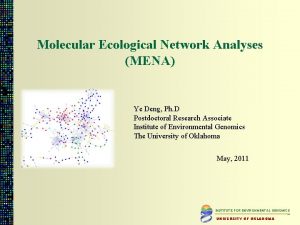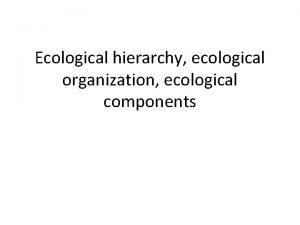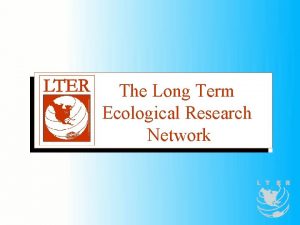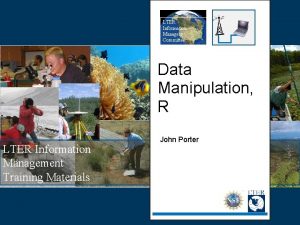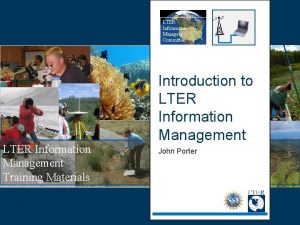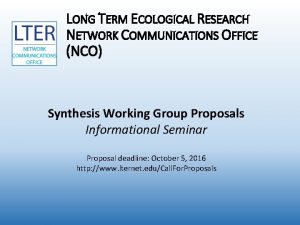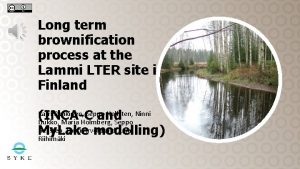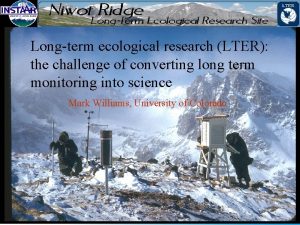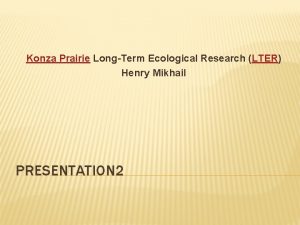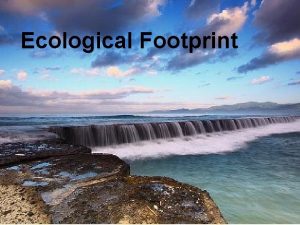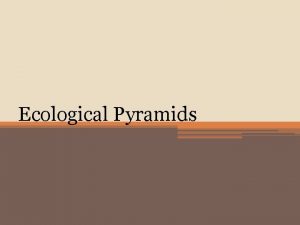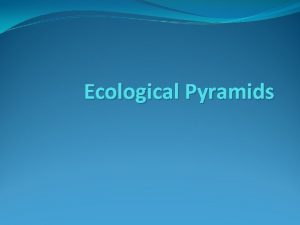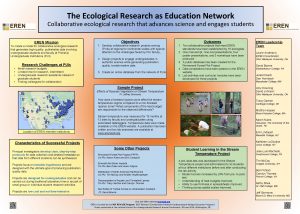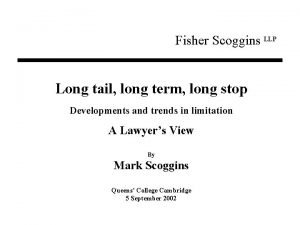LTER The Long Term Ecological Research Network LTER


















- Slides: 18

LTER The Long Term Ecological Research Network

LTER Network Vision, Mission and Goals Network Vision: A society in which exemplary science contributes to the advancement of the health, productivity, and welfare of the global environment that, in turn, advances the health, prosperity, welfare, and security of our nation. Network Mission: To provide the scientific community, policy makers, and society with the knowledge and predictive understanding necessary to conserve, protect, and manage the nation's ecosystems, their biodiversity, and the services they provide. The LTER Executive and Coordinating Committee have developed a set of Network Goals, and is creating a prioritized set of Objectives, Tasks and Metrics under each of those Goals. Understanding: To understand a diverse array of ecosystems at multiple spatial and temporal scales. Synthesis: To create general knowledge through long-term, interdisciplinary research, synthesis of Information: Legacies: Education: Outreach: information, and development of theory. To inform the LTER and broader scientific community by creating well designed and well documented databases. To create a legacy of well-designed and documented long-term observations, experiments, and archives of samples and specimens for future generations. To promote training, teaching, and learning about long-term ecological research and the Earth’s ecosystems, and to educate a new generation of scientists. To reach out to the broader scientific community, natural resource managers, policymakers, and the general public by providing decision support, information, recommendations and the knowledge and capability to address complex environmental challenges.


Initial cohorts were funded primarily by the Division of Environmental Biology, but other Directorates added funding for specific sites. MCR CCE GEO-OCE SBC GCE FCE PIE BES CAP MCM SBE, EHR Polar PAL HFR SEV LUQ VCR DEB KBS HBR BNZ ARC JRN CDR ILL OKE SGS NIN NWT KNZ CWT AND NTL 1980 1985 1990 1995 2000 2005 2010

LTER Funding FY 04 -05 • From BIO/DEB: – 04 Core funding – 04 Supplements $15, 629, 722 (81%) $1, 960, 000 – 05 Core request – 05 Supplement request $18, 000 (78%) $1, 960, 000 • From the rest of NSF – 04 Core funding – 04 Supplements $3, 726, 650 $1, 321, 629 – 05 Core request – 05 Supplement contributions $4, 871, 000 ?


EMPHASIS • Hypothesis-driven research • Evaluations are based on research productivity • Long-term monitoring encouraged, but no reward • LTER’s are NOT research platforms

Long-term research is required to reveal: • • • Slow processes or transients Episodic or infrequent events Trends Multi-factor responses Processes with major time lags

Duration of all observational and experimental studies N = 623 Eighty percent of studies in the ecological literature last less than three years From Tilman, D. 1989. Ecological experimentation: strengths and conceptual problems. pp. 136 -157. In Likens, G. E. (ed). Long-Term Studies in Ecology. Springer-Verlag, New York.

LTER sites share a common commitment to long-term research on the following core topics: • Pattern and control of primary production • Spatial and temporal distribution of populations selected to represent trophic structure • Pattern and control of organic matter accumulation in surface layers and sediments • Patterns and movements of inorganic inputs through soils ground- and surface waters • Patterns and frequency of disturbance

Comparisons among sites focus on fundamental ecological principles

Network Management Tech nolo gy Graduate Student Soci al /E cono mic Scie nces Data Management International Synthesis Climate Education Publications

Network Office Task Integration The integration of the primary functions of the LTER Network Office with its core vision and mission is graphically depicted here. Supplements to the LNO Cooperative Agreement that support Core Task Areas overlap with the outer circle. Other funded grants stand outside the outer circle. Acronyms: • DARPA – Defense Advanced Research Projects Agency • SEEK – Science Environment for Ecological Knowledge • KNB – Knowledge Network for Biocomplexity • SDW – Spatial Data Workbench • ASM – All Scientists Meeting • DBI – Division of Biological Infrastructure • SLTER – Schoolyard LTER • ILTER – International Long Term Ecological Research Network • RDIFS – Resource Discovery Initiative for Field Stations • NIS – Network Information System

Key goals for the next decade from LTER 2000 -2010 Increase the pace of synthesis through activities such as site volumes, network-wide synthesis projects, multi-site synthesis projects, and database development Increase experimental and comparative crosssite research

What’s driving planning in the LTER Network • LTER 2010 White Paper • 20 -Year Review • Strategic Planning for Network and Network Office • LTER bylaws • NEON • Other national networks (e. g. CLEANER, CUAHSI, Earthscope) Implementation of a 2004 planning grant

What’s happening now? • Grand challenge science themes best addressed by LTER • Science themes need to be identified and proposals written • Governance needs to be reviewed if network-level funding becomes available • Integration of education and research must be addressed • Future planning must be addressed

A major challenge to the U. S. LTER network in the coming decade is the design and implementation of an information system that seamlessly facilitates intersite research. These binders contain 10 years of data collected in the Grassland section of the International Biosphere Programme, ca. 1978

RF Telemetry Macro-organisms Smart Sensor Web Instrumenting the Environment Micro-weather Stations Sap Flow Sensor Array Sensor Clustered MEMS Insects Minirhizotron Array Multiparameter Soil Probes Automated E-tongue ‘Smart Dust’ tagged Insects E-nose
 Short, medium and long term planning in education
Short, medium and long term planning in education Long term memory vs short term memory
Long term memory vs short term memory Short term human resources examples
Short term human resources examples Difference between long term and short term liabilities
Difference between long term and short term liabilities Long term liabilities
Long term liabilities Long-term goals
Long-term goals Research paper on financial planning and forecasting
Research paper on financial planning and forecasting Tall + short h
Tall + short h Once upon a time there was an old man
Once upon a time there was an old man Từ ngữ thể hiện lòng nhân hậu
Từ ngữ thể hiện lòng nhân hậu Concln
Concln In my understanding
In my understanding How to find the nth term of a sequence
How to find the nth term of a sequence Position to term rule worksheet
Position to term rule worksheet Minterm maxterm
Minterm maxterm Nth term rule
Nth term rule Term to term rule
Term to term rule Institutional medicaid
Institutional medicaid Long term financing
Long term financing










